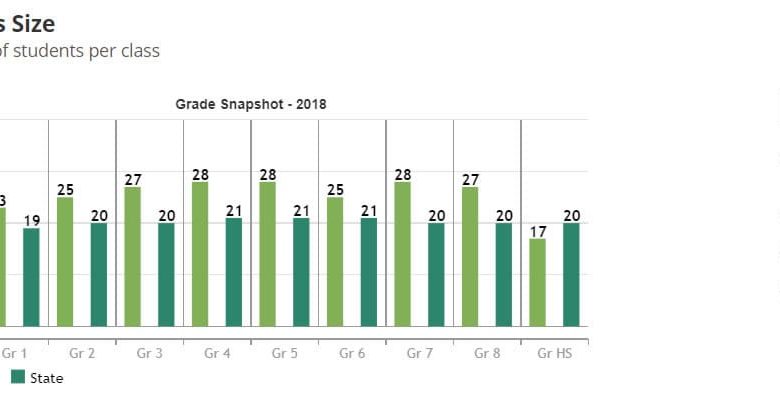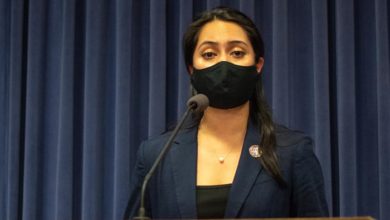Class size and district finances go hand-in-hand at Mahomet-Seymour

School class size and finances have been discussed at length around Mahomet and Seymour as the April 2nd election day approaches.
The two topics seem to go hand-in-hand, as much of the debt the Mahomet-Seymour School District has accrued has been related to land purchases and building facilities. The district’s “economic environment” has also set the benchmark for class sizes in kindergarten through fifth grade since 2013.
Now, with class sizes continually above the Illinois state average, according to the Illinois Report Card, Mahomet-Seymour parents and taxpayers, who see new development coming throughout the Village of Mahomet are asking, “where will all the students go?”
As some Mahomet-Seymour School Board candidates have questioned the present and future fiscal positions of the Mahomet-Seymour School District, space concerns about Middletown Prairie Elementary which was completed in 2018 have also been brought to the surface.
But class size, finances and facilities have not just been a discussion topic for the last month in the Mahomet-Seymour School District. Many of the topics that draw concern today were first brought up in 2010.
The possibility of new construction and building maintenance became a reality for school districts within Champaign County when a one-cent sales tax was allocated in 2009. Districts were also able to repay bonds with the funds they receive on a monthly basis. School districts started receiving these new revenues in April 2010.
Mahomet-Seymour’s first purchase was 139 lots that would have gone to home development, in Conway Farms Subdivision, in 2010. The 77.56 acres were purchased for $1.24 million.
By October 2011, Mahomet-Seymour Superintendent Keith Oates was hesitant about borrowing against future sales tax dollars, but said the district would “probably never catch the market any better” for bonding (2011, October 26, Mahomet Citizen).
During the same Mahomet-Seymour School Board meeting in 2011, Jeff Starwalt, who was the principal of Mahomet-Seymour Junior High at the time, discussed class sizes.
Enrollment at the junior high had dropped from 679 students in 2010 to 662 students in 2011, but Starwalt was concerned about the strain the district was putting on teachers and staff.
“We are just squeezing every resource we have and can’t squeeze any farther,” Starwalt said. (2011, October 26, Mahomet Citizen).
Built in 1960, and remodeled and renovated several times over the years, Mahomet-Seymour Junior High currently (2018 Illinois Report Card six-day attendance numbers) houses 773 students.
The 2011 board decided, though, the condition of Middletown Elementary, that was located on Division Street was grave. The board envisioned a Pre-K through second grade building that would replace the Middletown and Sangamon Elementary buildings.
That board also knew that a third building would be placed on the district’s newly purchased property, but the plan for which building that would be was vague.
Oates left the Mahomet-Seymour School District when he accepted a position as Superintendent in his hometown, Marion, in 2012.
***
Under the guidance of Superintendent Rick Johnston in 2013, the Mahomet-Seymour School Board began to realize its long-term vision for the property located off IL-150 (East Oak Street).
Ground was broken in 2012 for Phase I on a building that came to be known as Middletown Prairie Elementary.
Johnston dispelled rumors that the high school would be the next building to make the move. Instead, he announced that by 2022, the junior high school and athletic fields would be on the district’s newly purchased property, too (2013, December 5, Mahomet Citizen).
Mahomet-Seymour Junior High Principal, Heather Landrus, who replaced Starwalt when he moved to Lincoln Trail Elementary, in 2013 reiterated her predecessors’ comments about being at capacity at the junior high.
“It’s at capacity, if not over,” Landrus said. (2013, December 5, Mahomet Citizen).
With limited space throughout the district and limited financial resources to decrease class sizes, the Mahomet-Seymour School board created a guide to control class sizes.
The document shows that in the “current fiscal state” the district would create a new class for children when kindergarten classes were above 21 students, first grade above 24 students, second grade above 25 students and third through fifth grades above 28 students.
The plan also showed a willingness of the district to decrease class size as state funding became more consistently available.
Since 2013, as more students enrolled in the Mahomet-Seymour School District, administrators worked to make sure that the K-5 class sizes did not exceed their maximum “current fiscal state” limit, often times creatively finding spaces for new classes in buildings with dwindling classroom space when and where needed.
As Middletown Prairie Elementary Phase I was completed, the district gained a 55,000-square foot, $14 million building with 12 kindergarten classrooms.
Shortly after completion, the board approved the design and construction of Middletown Prairie Phase II, which included renovations to some of the newly built Pre-K and kindergarten building.
Knowing that students would be vacating Sangamon Elementary, the board also had the property rezoned commercial and appraised the 3.6 acres for $2.2 million.
Johnston’s vision through his tenure was to “create a model where our tax rate does not climb as we do these projects,” by using the $2.2 million a year the district receives from the Champaign County one-percent sales tax.
***
Johnston retired as Superintendent in 2017 before taking on the role of building construction consultant to oversee the completion of the Middletown Prairie Elementary build.
The Mahomet-Seymour Board of Education hired Lindsey Hall as superintendent to complete its vision for facilities and the education of students.
Hall guided the district through the sale of Sangamon Elementary for $750,000 in 2017. The first and second grade building built in 1951 (and added onto in 1988) housed 28 classrooms and three smaller classrooms for individualized or small group instruction (not including specials).
When Middletown Prairie opened to Pre-K to second grade students in 2018, the 130,000-square foot, $32.7 million building housed 37 full-sized classrooms (not including specials). The building also offers flex spaces for interventionists/small group instruction (2018, July 13, Mahomet Citizen).
While the district had plans to build a new junior high, Hall said the district needs to “get past a few benchmarks in terms of paying off debt” before being able to say it will construct a new junior high building in a June 2018 interview with the Mahomet Daily.
According to the Illinois State Board of Education’s 2019 Financial Report, the Mahomet-Seymour School District had 17.92 percent of its long-term borrowing limit left in 2018.
Although the district has borrowed against the Champaign County sales tax dollars for the new facilities, and plans to use some of the funds to build the new junior high, Hall said that the district will need additional funds to complete the project.
In the 2018 interview, Hall said, “We also know that in order to build the building that the district needs, we will have to go to our voters, as well.”
In an email interview last week to update the status of the statement, Hall said that a timeline or price tag has not been assigned to the project Johnston envisioned for 2022. She did say, though, that the land south of Middletown is “the logical place to build a new building.”
She also said that property tax dollars may also be needed to fund the junior high building. A cost on the project has not been established.
“None of this has been finalized,” Hall said. “Our community engagement initiative will very likely provide some direction from our stakeholders on future facilities plans, and we look forward to learning and listening.”
In the 2018 interview, Hall also said that class size and space for classrooms is something the district is aware of.
“We have some space to grow here (Middletown Prarie) in terms of extra classrooms,” she said. “So that’s good. Lincoln Trail has got a few; I don’t know the number, but for instance, we are adding a fourth-grade section (at the beginning of the 2018 school year). It means something else has to be moved, and it means another creative use of space somewhere else.
“I would say highest need, though, as we know, it’s the junior high. So long-term vision is to build a junior high out here (the property where Middletown Prairie is located).”
Hall said the district may get a couple more years out of the junior high space they have right now, though.
“If you look at what you might call the percentage of utilization of our buildings: so 100-percent would be like at the junior high and the high school, every classroom is used 100-percent of the day,” Hall said. “So teachers don’t have plan time alone in their classroom; and we’re not there yet.”
Not only are K-5 classroom sizes at the highest limited for Mahomet-Seymour standards, they are also consistently higher than the state average class size by grade, according to the Illinois Report Card.
Average class size according to the Illinois Report Card 2018
During her time as a health teacher, Hall said she had to travel from classroom to classroom and realizes that situation is not ideal.
“I don’t want to get to that point, but it’s an option. It’s not a good one,” she said.
Hall added that classroom size is not the only factor the district considers when it looks at meeting students’ needs.
She also added that with the evidence-based funding model that the State of Illinois adopted in 2018, there are other factors that go into the equation for class sizes and decisions of what staff the district needs to help a diverse student base, including those living in poverty or English language learners.
“We also know that our kids are coming to us with a wider variety of needs, and that serving them in gen ed classrooms is becoming more and more of a challenge in some cases,” Hall said. “We need all kind of personnel to support kids.”
Hall said hiring staff to help students with mental health issues and social emotional issues is equally important.
The Village of Mahomet’s landscape continues to grow and change with apartments, multi-use housing and additional single family dwellings on the way.
The Village of Mahomet Planning and Zoning minutes from 2016-2019 show at least 600 housing units are planned within Village limits in upcoming years. This does not include developments in unincorporated areas of Mahomet, Dewey, Seymour or the rural parts of Champaign where children attend the Mahomet-Seymour School District.
This number also does not include undeveloped areas of Conway Farms, Hunters Ridge or the Thornewood Subdivision.
With class sizes at maximum capacity and little room for additional classes in any building throughout the Mahomet-Seymour School District, Hall said the district has a lot to consider as it moves forward.
“We know that we have a couple more years of space, but we know that our enrollment is growing and we know that we want to manage class size, and we know that we’ve got some targets to hit based on research; they are down the road, we are not going to do it overnight,” Hall said.
“We’ve got some space, but we know the clock is ticking.”




